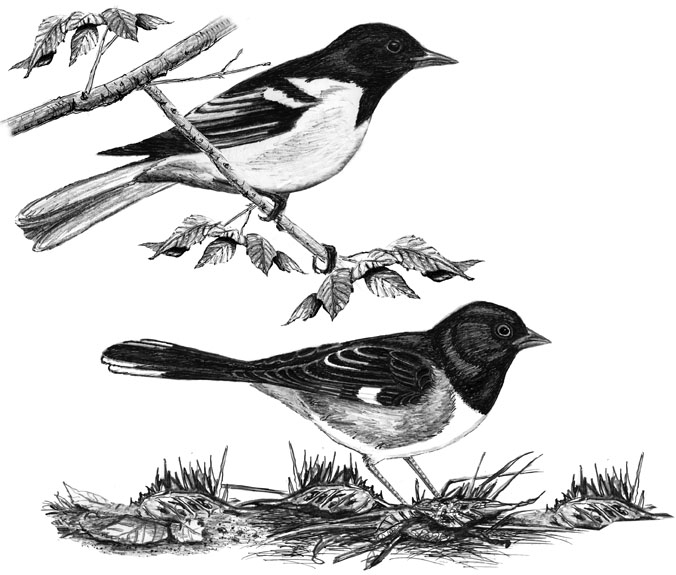
Dear Bird Folks,
Last year I told you about a Baltimore Oriole that was scratching on the ground under my birdfeeder. At the time you seemed skeptical saying, “It doesn’t sound like oriole behavior.” Well, the bird is back and this time I have proof. Check out the attached photo. It’s not the best picture (that’s my little finger in the way), but you can clearly see the oriole. Looks like I was right after all.
– Walter, Red Bank, NJ
Hold on, Walter,
I don’t know what you do for a living, but I sure hope you aren’t a lawyer. It’s nice that you presented some evidence to back up your story, but unfortunately for you, your proof supports my case. Last year I was indeed “skeptical” about your oriole and now I’m positive. The bird in your photo is not an oriole, not even close. It’s an Eastern Towhee. Photos don’t lie. Case closed. The evidence is so overwhelming that even the U.S. Supreme Court couldn’t screw this one up. Well…maybe.
The adult male Baltimore Oriole has a black head, is black on the back and is brilliant orange underneath. The adult male Eastern Towhee also has a black head and is black on the back. However, the orange is confined to his sides and the color isn’t nearly as brilliant; it’s more of a robin-ish orange. But the key difference between the two birds is behavior. Orioles spend most of their lives high up in trees eating fruit and insects, while the towhee is basically a fancy sparrow. It typically feeds on the ground by scratching in the dirt. You aren’t likely to see an oriole scuffling in the dirt, unless it has accidently dropped one of its contact lenses. Last week I wrote a column about how difficult it can be to tell all the different species of sparrows apart. (Remember LBJs – little brown jobs?) The Eastern Towhee is a sparrow, but it definitely isn’t an LBJ. It is colorful, distinctive and shouldn’t be confused with any other bird, except maybe an oriole, but only if you’re from Red Bank.
There are a few other clues you can use to identify an Eastern Towhee, but before I get into that I’d like to sneak in a bit of early American history. The towhee was one of the first birds recorded in North America. John White, the English artist and governor of the “Lost Colony” of Roanoke, NC, was so impressed with this bird that he made several drawings upon his arrival in the New World. White never finished these drawings, however. He went back to England for supplies and when he returned the colony had vanished. Everyone was gone, even little Virginia Dare. It has never been determined what happened to the Lost Colony, but so far no one has accused the towhees of any wrongdoing.
The towhee’s song is also helpful with identification. The male bird loves to sit on an exposed shrub and sing his characteristic song. Many other bird songs are hard to distinguish and are even harder to remember, but the male towhee song is distinctive. He clearly sounds like he is singing, “drink-your-teeeeea.” (No wonder the British were attracted to this bird.) The towhee also has several call notes. One sounds like it’s saying “tow-hee,” which is the reason for its common name. Another call sounds like “chewink.” While I admit that “towhee” is a rather strange name, I think the bird dodged a bullet when it wasn’t named the “Eastern Chewink.” It actually sounds insulting, like a name people from the Midwest might call New Englanders.
This bird’s feeding behavior is yet another identification clue. Towhees like to feed on the ground, but they don’t just walk and peck for food. They aggressively scratch on the ground, kicking with both feet in order to reveal hidden food. And they aren’t quiet about it either. More than once I’ve heard loud thrashing in the underbrush and envisioned Bigfoot about to come crashing out at me, only to hear a sweet “tow-hee” coming from the bushes. That sound still brings a smile to my face.
Towhees must be the ultimate party birds. If you look closely at one you’ll notice that it has red eyes, which it tough for the bird to explain after a night out. Oddly, not all towhees have this feature. The more sedate Southeastern birds have white eyes. This dissimilarity likely evolved eons ago during the Pleistocene era when Florida was an island, but you probably already knew that. What you might not know is that Eastern Towhees used to be called “Rufus-sided Towhees.” Older bird books say that Rufus-sided Towhees live across North America, from coast to coast. Then, a few years ago, some egghead (probably the same person who invented the Pleistocene era) decided that the western birds were a different species than the eastern birds. At that point the Rufus-sided Towhee ceased to exist. The western birds are now called “Spotted Towhees” and our birds have become “Eastern Towhees.” I know Eastern Towhee isn’t the best name, but it’s still better than being called an Eastern Chewink.
Sorry the bird in your photo wasn’t a Baltimore Oriole, Walter. But there is nothing wrong with having a towhee under your feeder. They’re fun birds to see. Also, don’t feel bad that the photo you sent isn’t the best. It’s perfectly fine with me that your little finger is in the picture. Over the years I’ve had a lot worse fingers sent my way (especially around April Fool’s Day), so a stray pinky isn’t going to bother me one bit.